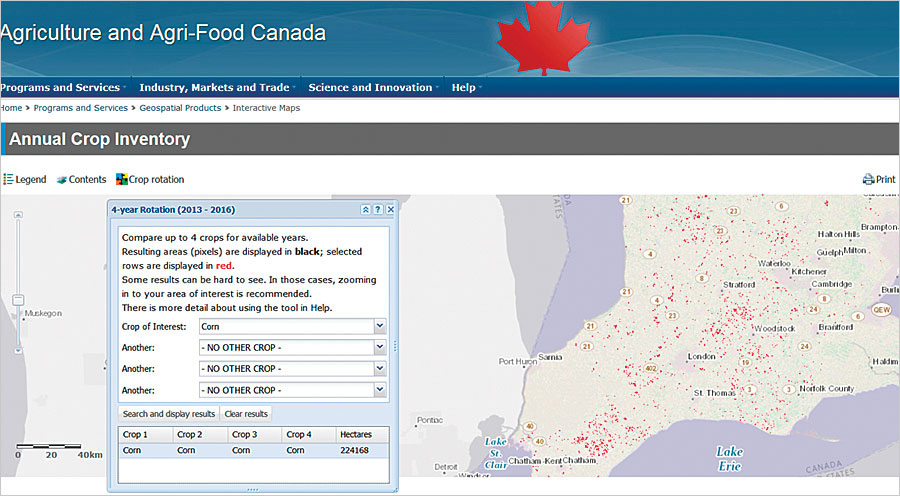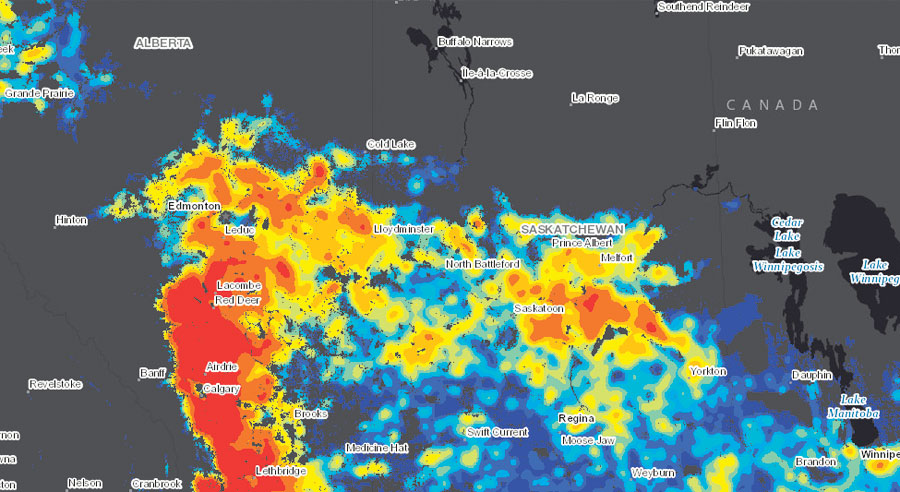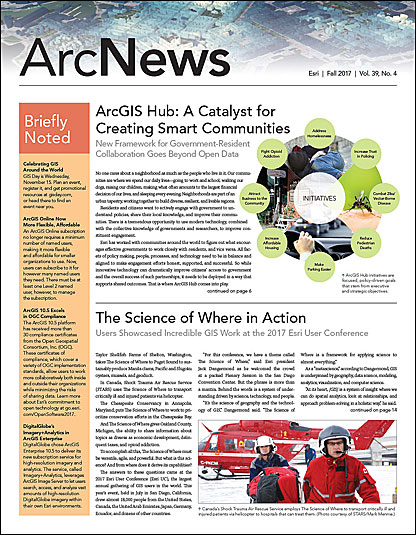Canadian Government’s Agriculture Department Develops Self-Serve Map- and App-Building Platform Using ArcGIS Online
The agricultural industry is facing unique agronomic, economic, and environmental challenges and opportunities—from extreme weather events and new invasive species to growing global competition. Consumer expectations are evolving as well. Canadians are demanding more variety and convenience from their food, as well as environmental friendliness and assurances of quality and safety.
Producers are looking for novel products and processes to help them meet the demands of these new markets while also ensuring that their operations are competitive and sustainable. Agriculture and Agri-Food Canada (AAFC), a government organization that aims to drive innovation and ingenuity in Canada’s agriculture and food industries, determined that one of the best ways to help the sector develop sustainably is to give as many organizations and people as possible the ability to visualize and effectively leverage the wealth of information—from crop density and soil moisture to farm locations and agri-environmental indicators—that is available to support decision-making in the industry today.
Using ArcGIS Online, AAFC is making that possible. Two years ago, the organization opened up its ArcGIS Online organizational account to almost 180 departmental users. Called UMAP, this AAFC-branded, cloud-based portal enables these users to employ a wide range of agricultural data to create interactive web maps and apps for their colleagues, food producers, and the public.
A Self-Serve Geospatial Destination
When this project started, AAFC had limited resources. So it wanted a solution that would require little in-house development and that would get the department up and running with making its own maps and apps quickly. The solution also needed to meet security requirements and integrate data according to government standards.

As a heavy user of the ArcGIS platform already, AAFC saw that ArcGIS Online met these requirements. Using it would give the team a secure, software-as-a-service (SaaS), cloud-based platform that is hosted and supported by Esri.
“We found the SaaS model very attractive because it meant that we could operate with a small server footprint,” said James Ashton, AAFC’s geomatics applications manager. In other words, the organization could focus on using the software rather than building it and maintaining the infrastructure.
Now, UMAP is a self-serve geospatial destination that AAFC staff can use to mash up key organizational information layers—such as annual crop inventories and historic yield and production statistics—with interoperable data from other organizations and third parties, like Esri. They can then use this data to create intelligent web maps that can be shared with specific interest groups or departments. Employees can also build on work previously completed by colleagues and share new results across the enterprise.
What’s more, employees designated as publishers can host their own, nonsensitive data in the cloud and create their own map services by converting CSV files into shapefiles to web enable them for ArcGIS Online. UMAP administrators monitor credit usage across the organization as well and choose which data to make public or keep private.
“The platform transforms our datasets into ready-to-use web resources that serve as powerful tools to communicate complex information in a very simple way,” said Ashton. “It significantly reduces confusion about where to access organizational maps and the need for departments to contact each other for information. This also reduces the number of requests received by our help desk.”
The UMAP home page has a customized banner, featured content, and links to training videos—all of which align with branding and objectives.
Disseminating Geospatial Data Efficiently
To make it easier to get data and apps to outside organizations and producers, AAFC also populated a public-facing app gallery with popular web apps.
“The demand for information is always increasing, and we’re seeing a much broader range of potential users,” said Ashton. “By leveraging a more efficient and cost-effective approach to disseminating geospatial data, we continue to transform ourselves into a knowledge-based department where we [employ] geospatial information in our decisions.”

Two of the public-facing web apps that AAFC staff recently developed and shared are the Annual Crop Inventory app and the Land Use app. The Annual Crop Inventory app allows users to quickly analyze and visualize field-level cropping patterns (i.e., an overview of what has been planted on farmland before) across Canada. The Land Use app enables users to analyze changes in land use throughout the country between 1990, 2000, and 2010. If a producer is interested in renting farmland, for example, he or she could use these maps to see which crops have been planted in previous years. That way, the producer can make the most effective and environmentally conscious decision about which land to farm and what to cultivate on it.
“A picture is worth a thousand words,” said Ashton. “Maps help us visualize the information we collect and that [the Science and Technology Branch at AAFC] creates. This, in turn, helps us ask better questions and make better decisions. Imagine how a farmer or policy maker could benefit from simple web-based access to open datasets on changes in land use, such as crop rotations or the environmental impacts of droughts.”
AAFC uses Esri templates, such as Compare Maps and specialized Canadian federal government ones, to build the apps quickly and in compliance with accessibility and common government branding requirements. By using ArcGIS Online in conjunction with templates, some apps—like the Spatial Density of Major Crops in Canada app—have taken only an hour to deploy.
In addition, AAFC registers its data, web services, and apps to the Federal Geospatial Platform (an internal government portal) and the public-facing Canadian Government’s Open Data Portal. By doing this, it ensures that these portals point back to AAFC’s services, giving more people—both internally and externally—access to the organization’s data.
Enabling Better Decision-Making
By using the ArcGIS platform to better inform internal staff, agricultural producers, and the public, AAFC is ensuring that more people can visualize and leverage the myriad information the department receives, meeting both consumer expectations and producer needs.
AAFC’s maps and apps are informing policy makers on a global scale, from grain brokers looking for new cereal sources to real estate scouts seeking new investment opportunities. Now, they can all see where specific cropping trends, like monocropping, are occurring and where forest or urban expansion are taking place. Using web maps, the department can share its data broadly and cost-effectively, allowing policy makers to easily collaborate in finding solutions to ongoing challenges.
For more information, email Gordon Plunkett, the spatial data infrastructure (SDI) director for Esri Canada, or call 613-683-6213.

